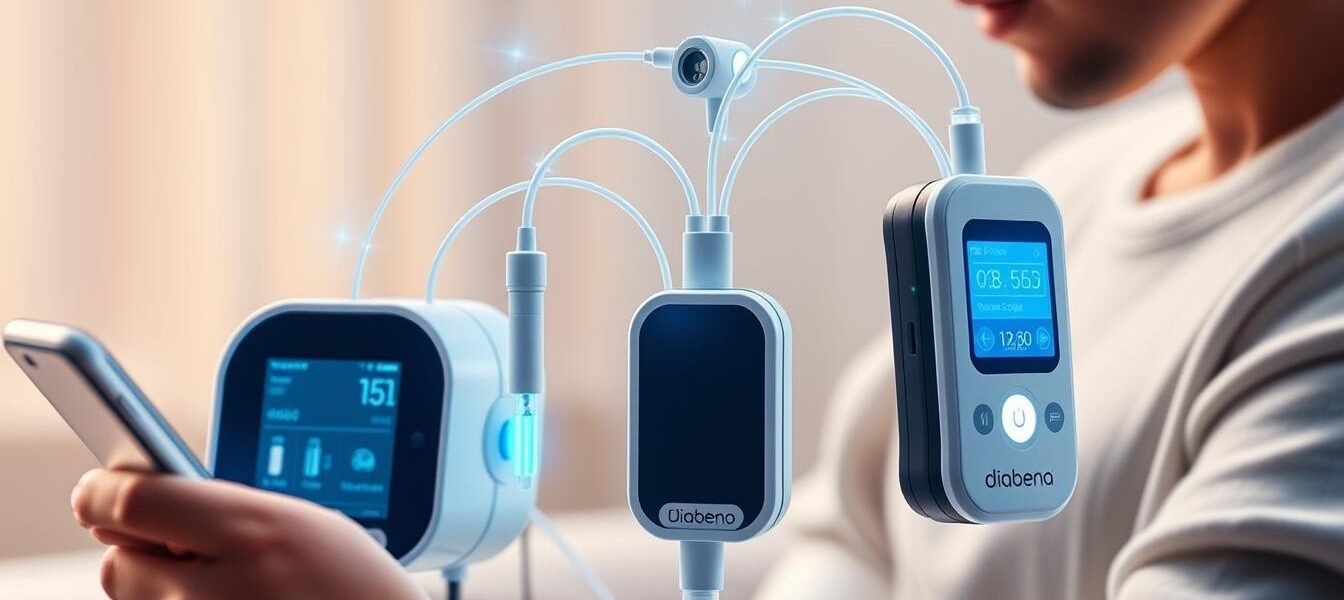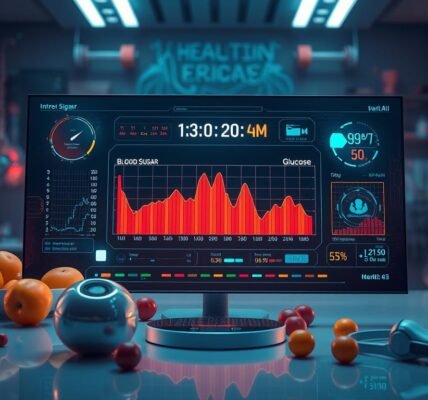“The greatest discovery of my generation is that a human being can alter his life by altering his attitude.” – William James. This saying is very true for people with type 1 diabetes. Hybrid closed-loop insulin systems change how they manage their diabetes. These systems, also known as artificial pancreas technology, bring new care options.
They help control blood sugar levels better. This is important because type 1 diabetes is becoming more common in kids. It’s growing by about 3% every year. Now, over a million young people under twenty have it worldwide1.
Even with new tech like insulin pumps and glucose monitors, blood sugar levels have gotten worse in kids over the last ten years1. Using these advanced systems could really help improve care and results for diabetes management.
Hybrid closed-loop systems combine glucose monitoring and insulin delivery. They offer big benefits in diabetes care. They help you manage your diabetes better every day.
Learning about these systems shows how they make managing diabetes easier. They also help you stay healthier.
Key Takeaways
- Hybrid closed-loop insulin systems automate insulin delivery, improving glycaemic control.
- These systems have shown to reduce the burden of diabetes management.
- They offer significant improvements in Time in Range (TIR) metrics, enhancing user quality of life.
- Healthcare professionals emphasize the importance of patient education regarding these technologies.
- Adopting an advanced insulin delivery system can lead to better health outcomes for young patients.
Introduction to Hybrid Closed-Loop Insulin Systems
Hybrid closed-loop insulin systems are a big step forward in diabetes care. They combine insulin pump therapy with continuous glucose monitoring (CGM). This mix helps control blood sugar by adjusting insulin based on current glucose levels.
For example, CamAPS FX is for kids aged 1 and up, while Omnipod 5 is for those 2 and older. Medtronic 670G and 780G are for kids 7 and up, and Control IQ is for kids 4 and older2. These systems have changed how we manage diabetes, making it easier and less dependent on manual work.
Systems like Control-IQ on the t:slim X2 insulin pump keep blood sugar between 70-180 mg/dL. It automatically corrects blood sugar levels and helps users feel more at ease3. This technology also lets people enjoy daily activities more freely, like exercising and eating.
For nearly 20 years, research has been key in developing these systems. It’s crucial to keep improving them to help people with diabetes. Tools and apps can make managing type 1 diabetes easier and more motivating. These advancements make diabetes care more user-friendly, leading to better health for those with diabetes2.
The Evolution of Diabetes Management Technology
The journey of diabetes management technology has seen a big change over the years. It has made insulin therapy better and given patients more control. From old methods that needed lots of manual work to today’s advanced closed-loop system innovation, the progress shows a big effort to improve blood sugar control.
Historical Context of Insulin Therapy
In the mid-1950s, the arrival of disposable syringes was a big step forward. It made insulin injections less painful and safer from infections4. The first insulin pens came out in 1985, making dosing more precise. But it wasn’t until 2007 that the first “smart pen” was introduced, tracking insulin use4.
Even with these improvements, only a quarter of people with type 1 diabetes hit the glycemic target of HbA1c 3. The 1970s saw the start of CSII pumps, which are now more portable and tailored to individual needs5. Using insulin pumps has shown to improve blood sugar control and reduce hypoglycemic events compared to injections5.
Advancements in Diabetes Devices
The introduction of continuous glucose monitoring (CGM) devices in 1999 changed how we measure glucose. It made monitoring more accurate and let patients make better decisions about their insulin delivery system needs5. The first real-time CGM came out in 2004, showing big improvements in accuracy and user experience4.
The MiniMed 670G was launched in 2016, using CGM data to automate insulin delivery. This has made diabetes care better5. Hybrid closed-loop systems have also shown to improve glucose control by 8-12 percentage points for adults and children with type 1 diabetes6.
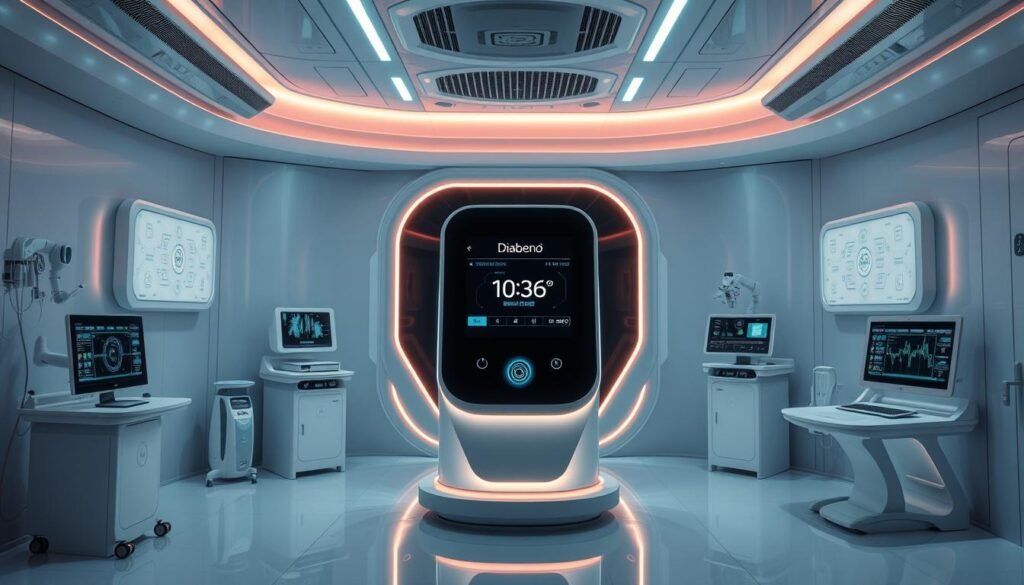
Understanding How Hybrid Closed-Loop Systems Work
Hybrid closed-loop systems are a big step forward in treating diabetes. They use continuous glucose monitoring (CGM) and automated insulin delivery. This combo helps manage blood sugar levels by adjusting insulin based on your needs.
The Role of Continuous Glucose Monitoring
Continuous glucose monitoring devices track your blood sugar levels in real-time. They check your glucose every few minutes. This lets you make quick changes to keep your blood sugar stable.
The Functionality of Automated Insulin Delivery
Automated insulin delivery uses CGM data to adjust insulin levels. It handles different situations, like low blood sugar or high glucose levels. This can improve your time spent in a healthy glucose range by up to 15% at night7.
Using these systems can also lower the risk of low blood sugar and improve your HbA1c levels by about 0.5%7. It’s important to keep an eye on your settings and make adjustments as needed. This will help you get the most out of managing your diabetes8.
Benefits of Hybrid Closed-Loop Insulin Systems
Hybrid closed-loop insulin systems offer big medical and mental benefits. They help manage diabetes better and make life better for users. This new system makes controlling blood sugar easier and more reliable.
Improved Glycaemic Control
Studies show these systems keep blood sugar in a healthy range more often. A big study found they improved blood sugar control by 9.6 percentage points9. People using them also had lower blood sugar levels, up to 0.4% lower than usual treatments9.
This better control is key. It lowers the chance of serious problems and helps avoid dangerous conditions like diabetic ketoacidosis.
Enhanced Quality of Life for Diabetic Patients
The mental benefits are huge. Users find it easier to live their daily lives thanks to less hassle with diabetes. Many parents of diabetic kids see a big drop in their time spent on diabetes care, making life better for them10.
These systems let people do more without worrying about constant checks. It’s a big win for those with diabetes.

In short, hybrid closed-loop systems are a game-changer. They help control blood sugar better and improve life for those with diabetes.
Reduction of Daily Management Burden
Hybrid closed-loop insulin systems are changing how we manage diabetes. They make daily tasks easier by automating insulin dosing. This means less time spent on tedious calculations.
Mental Relief from Constant Calculations
Using these advanced technologies brings mental relief. It reduces the stress of constant blood sugar checks and insulin adjustments. You can now focus on other things in your life, not just diabetes.
Decreased Number of Daily Decisions
These systems make your daily routine simpler. They cut down on the decisions you need to make about diabetes care2. This improvement in life quality gives you more mental space to enjoy other activities.
Time in Range: A Key Metric for Diabetes Control
The time in range (TIR) is key for managing diabetes well. It’s how long your blood sugar stays in a safe range set by doctors. Staying in this range helps avoid serious diabetes problems.
What Does Time in Range Mean?
Time in range is more than just a number. It’s crucial for controlling diabetes. A study with 13,461 MiniMed 780G users showed young people averaged 71.2% TIR, while adults had 73.9%11. This shows how new systems can help keep blood sugar healthy.
Comparison with Traditional Management Methods
Hybrid closed-loop systems differ a lot from old ways of managing diabetes. Old methods need manual work and constant checks, causing blood sugar swings. But, the MiniMed 780G users hit over 55% TIR, with 93% of adults over 15 reaching it12. So, new systems are better at keeping blood sugar steady.
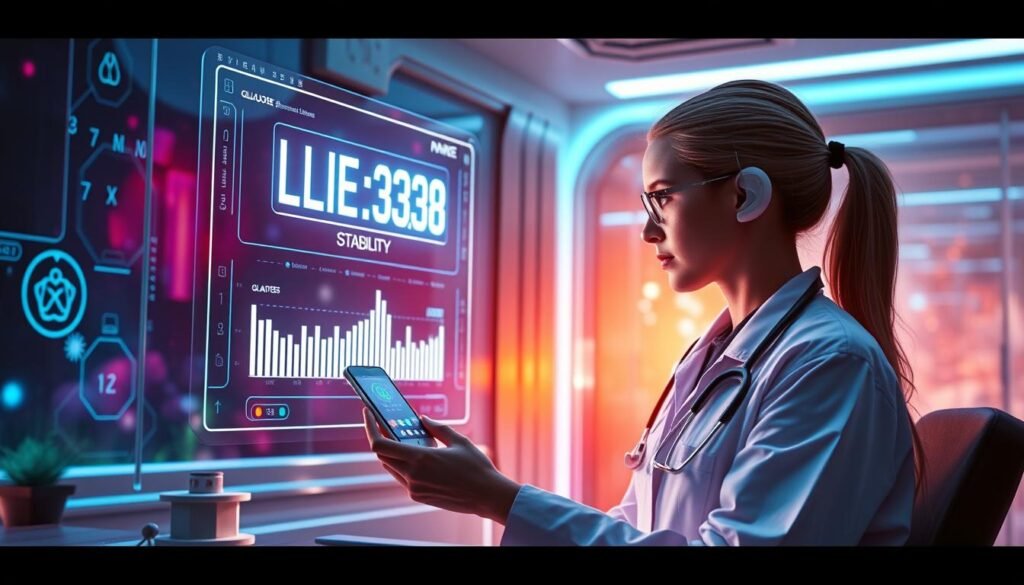
| Age Group | Average TIR (%) | Achieved TITR > 55% |
|---|---|---|
| 15 years or younger | 71.2% | 93% |
| Older than 15 years | 73.9% | 81% |
This shows hybrid closed-loop systems greatly improve diabetes management. They make life better for people with diabetes by keeping their blood sugar in a good range1112.
Hybrid Closed-Loop Insulin Systems and Adolescents
Managing diabetes is tough for teens because of changing insulin needs and lifestyle. Hybrid closed-loop systems are a new hope. They aim to make diabetes care easier for young people. These systems are designed to be easy to use, which is key for teens to stick with them.
Studies show these systems can really help teens manage their diabetes better.
Challenges Faced by Young Patients
Teens face many challenges in managing their diabetes. Their schedules change a lot, and they often feel pressure from friends. This can make it hard to keep insulin levels steady.
In one study, 570 patients saw big improvements in managing their blood sugar levels. This shows how important it is to have a system that fits their changing lives.
Compliance and Usability Insights
Getting teens to stick with their diabetes care is crucial. Hybrid closed-loop systems, like the Medtronic MiniMed™ 670G, have shown great results. They help teens keep their blood sugar levels in check.
The design of these systems makes them easy for teens to use. Getting teens involved in the design can make them more likely to use the systems.
| System | Mean Time in Range (%) | Severe Hypoglycemia Events | P-Values for Key Comparisons |
|---|---|---|---|
| Medtronic MiniMed™ 670G | 37±9% | None | P |
| Medtronic Advanced Hybrid Closed-Loop (AHCL) | 34±9% | 1 event | P |
| Study Population | Stable above 70% TIR | No severe events | N/A |
Hybrid closed-loop systems offer big benefits for teens with diabetes. They make managing diabetes easier and more effective. This is a big step forward for young patients131415.
Customization and Personalization in Diabetes Care
In the world of diabetes care, making hybrid closed-loop systems fit each person’s needs is key. Only 2 million out of many millions worldwide use insulin pumps because of cost and complexity16. In Europe and the U.S., many patients use multiple daily insulin injections (MDI) pens. This makes it hard to meet everyone’s needs in diabetes care17.
Adapting to Individual Insulin Sensitivity
Diabeloop’s DBL-4pen is made to help pen users manage their diabetes better. It gives real-time insulin dose advice, making diabetes management easier16. Patients just need to enter meal and activity info to get personalized advice. This way, insulin doses can change based on glucose levels and patient history17.
Real-time Adjustments and Adaptive Algorithms
Adaptive algorithms in diabetes devices are crucial for custom insulin delivery. They help control glucose levels and make managing diabetes easier. Diabeloop’s work with BIOCORP aims to make these devices even better16. As research and tech improve, diabetes care is set to get even better.
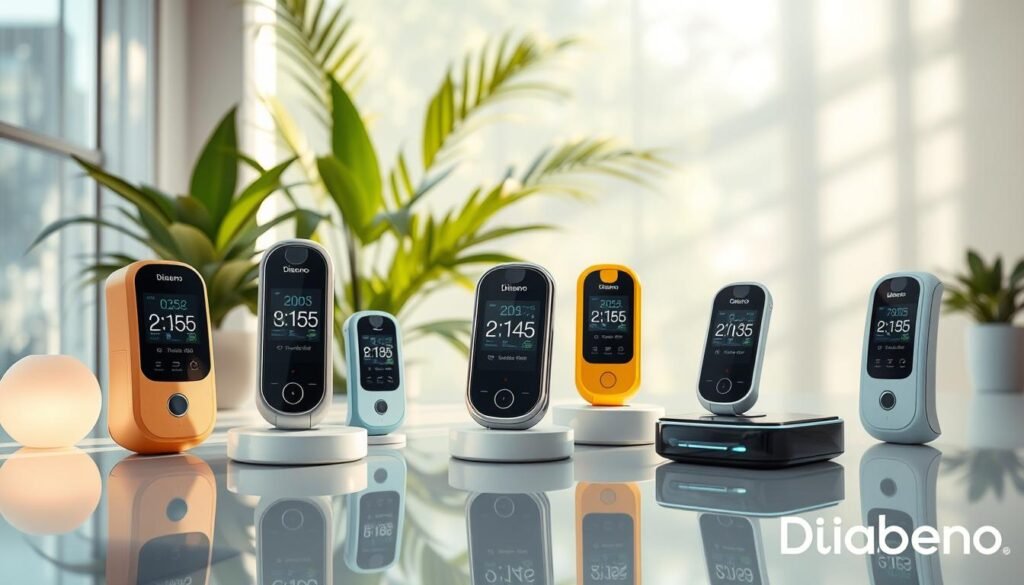
Advanced Technology Behind Hybrid Closed-Loop Systems
Advanced technology is key to the success of hybrid closed-loop insulin systems. These systems use insulin delivery algorithms to adjust insulin doses based on real-time glucose levels. This helps meet the user’s specific insulin needs, improving diabetes management.
The Importance of Algorithms in Insulin Delivery
The heart of hybrid closed-loop insulin systems is their insulin delivery algorithms. These algorithms help deliver precise doses of insulin. Studies show they can greatly improve HbA1c levels, showing their effectiveness in controlling blood sugar.
Hybrid systems have been shown to improve HbA1c levels in Type 1 Diabetes (T1D) patients. They also reduce hypoglycemia occurrences compared to traditional insulin therapy18. Continuous glucose monitoring with these algorithms helps users stay in range more often. It also cuts down time spent in high glucose levels by up to 27%18.
Smart Insulin Delivery Technologies
Smart insulin delivery technologies add to the effectiveness of diabetes management. Devices like the MiniMed™ 780G CGM system use SmartGuard® technology for automatic corrections up to 12 times an hour. This adapts to changes in glucose levels.
Users of advanced hybrid closed-loop systems spend more time in target glucose ranges than traditional methods18. Innovations, like the Guardian™ Sensor 4, allow for continuous glucose monitoring under the skin. This provides consistent and accurate insulin adjustments18.
Impact on Long-term Diabetes Complications
Managing type 1 diabetes long-term aims to prevent serious complications. Hybrid closed-loop systems are key in keeping blood sugar stable. Studies show these systems greatly lower the risk of long-term issues by controlling blood glucose well.
Users of these systems see big improvements in managing their diabetes. They keep their HbA1c levels healthy and reduce blood sugar swings.
Establishing Reliable Glucose Control
Keeping blood sugar in check is vital for diabetes patients. Hybrid closed-loop systems have shown great success in this area. They led to a 7 mmol/mol drop in HbA1c after a year19.
Also, the time spent with blood sugar in the safe range went up a lot20. This means better blood sugar control and fewer ups and downs during the day. It makes you feel safer and less worried about low blood sugar.
Reducing Risk of Diabetic Ketoacidosis
Lowering the risk of diabetic ketoacidosis is key, especially for young people with diabetes. Closed-loop systems have shown they can cut severe low blood sugar by 50%19. This not only improves your life but also keeps you safe from the dangers of diabetic ketoacidosis.
As more research comes out, these systems are becoming a top choice for kids with diabetes. They are at higher risk, and these systems help keep them safe1.

The Role of Healthcare Professionals in Implementation
Healthcare professionals play a key role in making hybrid closed-loop insulin systems work. They need to educate themselves and their patients well. This is crucial for using advanced diabetes technology to better support and manage patients.
Provider Education on Hybrid Systems
Healthcare professionals must grasp the details of hybrid closed-loop systems. They should get training that covers:
- How to use the system and its features.
- Ways to improve blood sugar control and life quality.
- Common issues patients face with these technologies.
Only a quarter of people with type 1 diabetes hit the glycemic targets. This shows the need for good training to help patients do better21. Keeping up with new tech and addressing patient worries is key22.
Supporting Patients on Their Journey
Helping patients is more than just teaching them. It’s about creating a supportive space for their diabetes journey. Important support includes:
- Regular check-ins to see how they’re doing with the tech.
- Access to mental health help for diabetes stress and fear of low blood sugar.
- Working together to fit the tech into their daily lives.
Studies show patients using these systems feel better mentally and have a better quality of life23. By supporting patients, healthcare professionals can help them overcome challenges and enjoy the benefits of new technology. This leads to better health for everyone.
Real-world Data and User Experiences
Gathering real-world data from users is key to understanding hybrid closed-loop systems’ impact on diabetes. These experiences show how these systems fit into daily life and affect results.
Peer Experiences with Hybrid Closed-Loop Systems
Users love hybrid closed-loop systems, seeing big improvements in blood sugar control. For example, using these systems lowered HbA1c from 8.06% to 7.37%, showing better long-term blood sugar management24. There was also an 18.2% increase in time spent in the target range, making daily management better24. Plus, users did fewer sensor calibrations, averaging 3.26 per day, making monitoring easier25.
Case Studies and Clinical Trials Insights
Clinical trials offer deep insights into hybrid closed-loop systems’ effectiveness. A study with over 4,120 Type 1 Diabetes patients using the MiniMed™ 780G system showed a mean time in range of 83.0%, a big win for blood sugar control26. Patients who set the system right achieved a time in range of 78.8%, showing the system’s role in tailored diabetes care26. Also, real-world data show a drop in time spent in hypoglycemia, proving these systems are safe and work well26.

Comparative Analysis of Available Hybrid Closed-Loop Systems
In today’s world, hybrid closed-loop insulin systems are key for better diabetes control. Knowing the market options is crucial for making smart choices in diabetes care.
Overview of Market Options
The main players in hybrid closed-loop systems are Medtronic MiniMed 670G, MiniMed 780G, and Tandem’s Control-IQ. Each insulin pump system has unique diabetes technology features for different patient needs.
- Medtronic MiniMed 670G: Approved by the FDA in 2017, it’s for those aged seven and up. It uses real-time glucose data for monitoring and insulin delivery.
- Medtronic MiniMed 780G: It can give up to twelve correction boluses per hour. This shows its advanced ability in managing blood sugar levels27.
- Tandem Control-IQ: For users aged fourteen and above, it can give one correction bolus per hour. It aims to improve time in the target glucose range during daily use.
Features of Different Systems
When comparing these systems, we look at their features and how they affect user experience and results. The International Consensus sets clear goals for glycemic control, including a Time in Range (TIR) of over 70%. It also sets limits for time below and above range, helping to judge system performance27.
| System | Age Group | Correction Bolus Frequency | Time in Range Improvement |
|---|---|---|---|
| Medtronic MiniMed 670G | 7+ | Up to 1/hour | TIR increased by 42% during use28 |
| Medtronic MiniMed 780G | 7+ | Up to 12/hour | TIR over 75% post six-month use27 |
| Tandem Control-IQ | 14+ | Up to 1/hour | TIR reports up to 73.5% in studies29 |
Each system has been shown to lower the time glucose levels are too high. This improves patient safety and health outcomes29. Knowing these differences helps you pick the best system for your needs.
Challenges and Considerations with Hybrid Systems
Switching to hybrid closed-loop insulin systems comes with its own set of challenges. You’ll need to learn a lot about the technology and how it works. This includes understanding the insulin pump, continuous glucose monitor, and the algorithms that control insulin delivery.
Learning Curve and Adaptation
Getting used to hybrid systems means adjusting to new ways of doing things. You’ll need to learn the basics and how to handle alerts from your device. Working with your healthcare team and using available resources can make this easier. This way, you can overcome the hurdles and feel more confident in using the technology.
Potential Technical Glitches
Even with their benefits, these systems can have technical problems. Issues like blocked or dislodged cannulas can lead to emergencies30. Knowing how to fix these problems is key. Having a plan for when things go wrong or your health changes is crucial.

It’s important to remember that hybrid closed-loop systems are not a complete solution for diabetes management. They can help control blood sugar and reduce the risk of low blood sugar. But, you still need to stay vigilant and proactive about your health to get the best results.
The Future of Hybrid Closed-Loop Insulin Systems
Technology keeps getting better, and so does the future of hybrid closed-loop insulin systems. We can expect better designs and more features. These changes aim to make managing diabetes easier and more comfortable for everyone.
Innovations on the Horizon
New insulin delivery systems are on the rise, bringing hope to those with diabetes. Medtronic’s MiniMed 670G, launched in 2016, was a big step forward. It showed how these systems can improve blood sugar control and user experience31.
More improvements are coming, making insulin pumps even more effective. This will help in managing diabetes worldwide. Better sensors and algorithms will also enhance continuous glucose monitoring (CGM). This means patients might not need to adjust their settings as often5.
Future Research Directions
There are many research paths to explore for better diabetes care. One area is making systems more user-friendly by analyzing data in real-time. This could lead to systems that adapt better to individual needs5.
Studies might also look into how these systems affect people’s lives over time. This is important for the nine million with type 1 diabetes worldwide5. Improving predictive abilities could also help prevent dangerous blood sugar drops. All these areas could greatly improve diabetes management in the future.
Conclusion
The impact of hybrid closed-loop insulin systems on diabetes care is huge. With type 1 diabetes rising by about 3% yearly, we need new ways to control blood sugar1. These systems have shown great results, like an 11% jump in TIR for kids aged 6-131.
This improvement means better blood sugar control, which lowers the risks of diabetes complications1. It also makes life better for people with diabetes1.
Technologies like the MiniMed 670G and T:slim X2 show how these systems are getting better31. They let you make quick changes to your treatment plan31. This makes managing diabetes easier, freeing up time for other things32.
As research continues, we can expect even more progress in diabetes care32. Hybrid closed-loop insulin systems are a big step towards a better life for those with diabetes32.
FAQ
What are hybrid closed-loop insulin systems?
How do hybrid closed-loop systems benefit diabetes management?
What is the role of continuous glucose monitoring in these systems?
How does the hybrid closed-loop system improve quality of life for diabetic patients?
What is “Time in Range,” and why is it important?
Can hybrid closed-loop systems cater to adolescents with type 1 diabetes?
How do these systems personalize diabetes care?
What advancements in technology enhance hybrid closed-loop systems?
How do hybrid closed-loop systems impact long-term diabetes complications?
What role do healthcare professionals play in the implementation of these systems?
What insights do real-world data provide about hybrid closed-loop systems?
What are the challenges in transitioning to hybrid closed-loop systems?
What does the future hold for hybrid closed-loop insulin systems?
Source Links
- https://pmc.ncbi.nlm.nih.gov/articles/PMC8119627/
- https://breakthrought1d.org.uk/knowledge-support/managing-type-1-diabetes/guide-to-type-1-diabetes-technology/hybrid-closed-loop-technology-artificial-pancreas/
- https://www.tandemdiabetes.com/support/diabetes-education/managing-diabetes/closed-loop-insulin-pump
- https://www.texaschildrens.org/content/wellness/celebrating-our-centennial-milestone-diabetes-technology-across-years
- https://pmc.ncbi.nlm.nih.gov/articles/PMC10448576/
- https://link.springer.com/article/10.1007/s00125-024-06165-w
- https://pmc.ncbi.nlm.nih.gov/articles/PMC10132000/
- https://www.rch.org.au/uploadedFiles/Main/Content/diabetes/Hybrid Closed Loop info sheet.pdf
- https://link.springer.com/article/10.1007/s00125-021-05391-w
- https://www.diabetes.org.uk/about-diabetes/looking-after-diabetes/technology/closed-loop-systems
- https://pmc.ncbi.nlm.nih.gov/articles/PMC11043222/
- https://link.springer.com/article/10.1007/s13300-024-01656-w
- https://pmc.ncbi.nlm.nih.gov/articles/PMC9194961/
- https://www.mdpi.com/2072-6643/16/14/2210
- https://www.nature.com/articles/s41598-023-40423-y
- https://www.diabeloop.com/media-press/press-releases/diabeloop-adapts-its-self-learning-personalized-insulin-automatization-software-to-be-used-with-insulin-pens
- https://www.globenewswire.com/news-release/2022/04/12/2421183/0/en/Diabeloop-Adapts-Its-Self-Learning-Personalized-Insulin-Automatization-Software-to-Be-Used-With-Insulin-Pens.html
- https://hcp.medtronic-diabetes.com.au/advanced-hybrid-closed-loop
- https://bmcmedicine.biomedcentral.com/articles/10.1186/s12916-024-03396-x
- https://drc.bmj.com/content/10/2/e002633
- https://pmc.ncbi.nlm.nih.gov/articles/PMC11457686/
- https://pmc.ncbi.nlm.nih.gov/articles/PMC7317734/
- https://link.springer.com/article/10.1007/s13300-022-01299-9
- https://pmc.ncbi.nlm.nih.gov/articles/PMC9294561/
- https://pmc.ncbi.nlm.nih.gov/articles/PMC6832708/
- https://link.springer.com/article/10.1007/s13300-023-01427-z
- https://www.frontiersin.org/journals/endocrinology/articles/10.3389/fendo.2023.1099024/full
- https://www.healthpartners.com/knowledgeexchange/display/document-rn23801
- https://link.springer.com/article/10.1007/s13300-023-01394-5
- https://www.stemlynsblog.org/podcast-hybrid-closed-loop-insulin/
- https://pmc.ncbi.nlm.nih.gov/articles/PMC9207329/
- https://diabetes.jmir.org/2023/1/e45241/
